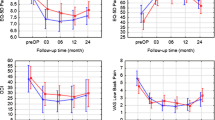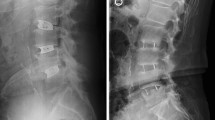Abstract
Background
A comparison of fusion rates and clinical outcomes of instrumented transforaminal interbody fusion (TLIF) between polyetheretherketone (PEEK) and titanium-coated PEEK (Ti-PEEK) cages is not well documented.
Methods
A single-centre, prospective, randomised study included patients who underwent one-level TLIF between L3-S1 segments. Patients were randomised into one of two groups: TLIF surgery with the PEEK cage and TLIF surgery with the Ti-PEEK cage. Clinical results were measured. All patients were assessed by repeated X-rays and 3D CT scans. Cage integration was assessed using a modified Bridwell classification. The impact of obesity and smoking on fusion quality was also analysed. Patients in both groups were followed up for 2 years.
Results
Altogether 87 patients were included in the study: of these 87 patients, 81 (93.1%) completed the 2-year follow-up. A significant improvement in clinical outcome was found in the two measurements scales in both groups (RM: p = 0.257, VAS: p = 0.229). There was an increase in CobbS and CobbL angle in both groups (p = 0.172 for CobbS and p = 0.403for CobbL). Bony fusion was achieved in 37 of 40 (92.5%) patients in the TiPEEK group and 35 of 41 (85.4%) in the PEEK group (p = 0.157). Cage subsided in 2 of 40 patients (5%) in the TiPEEK group and 11 of 41 (26.8%) in the PEEK group (p = 0.007). Body mass index > 30 and smoking were not predictive factors of bony fusion achievement.
Conclusion
There is no significant advantage of TiPEEK cages over PEEK cages in clinical outcome and fusion rate 2 years after surgery.



Similar content being viewed by others
References
Briggs H, Keats S (1947) Laminectomy and foraminotomy with chip fusion; operative treatment for the relief of low-back pain and sciatic pain associated with spondylolisthesis. J Bone Joint Surg Am 29:328–334
Agazzi S, Reverdin A, May D (1999) Posterior lumbar interbody fusion with cages: an independent review of 71 cases. J Neurosurg 91:186–192
Fritzell P, Hagg O, Wessberg P, Nordwall A, Swedish Lumbar Spine Study G (2002) Chronic low back pain and fusion: a comparison of three surgical techniques: A prospective multicenter randomized study from the swedish lumbar spine study group. Spine 27:1131–1141
Mobbs RJ, Phan K, Malham G, Seex K, Rao PJ (2015) Lumbar interbody fusion: Techniques, indications and comparison of interbody fusion options including plif, tlif, mi-tlif, olif/atp, llif and alif. J Spine Surg 1:2–18
Hsieh PC, Koski TR, O’Shaughnessy BA, Sugrue P, Salehi S, Ondra S et al (2007) Anterior lumbar interbody fusion in comparison with transforaminal lumbar interbody fusion: implications for the restoration of foraminal height, local disc angle, lumbar lordosis, and sagittal balance. J Neurosurg Spine 7:379–386
De Bartolo L, Morelli S, Bader A, Drioli E (2001) The influence of polymeric membrane surface free energy on cell metabolic functions. J Mater Sci Mater Med 12:959–963
Gittens RA, Olivares-Navarrete R, Schwartz Z, Boyan BD (2014) Implant osseointegration and the role of microroughness and nanostructures: Lessons for spine implants. Acta Biomater 10:3363–3371
Fujibayashi S, Takemoto M, Neo M, Matsushita T, Kokubo T, Doi K et al (2011) A novel synthetic material for spinal fusion: a prospective clinical trial of porous bioactive titanium metal for lumbar interbody fusion. Eur Spine J 20:1486–1495
Vadapalli S, Sairyo K, Goel VK, Robon M, Biyani A, Khandha A et al (2006) Biomechanical rationale for using polyetheretherketone (peek) spacers for lumbar interbody fusion-a finite element study. Spine 31:E992-998
Massaad E, Fatima N, Kiapour A, Hadzipasic M, Shankar GM, Shin JH (2020) Polyetheretherketone versus titanium cages for posterior lumbar interbody fusion: meta-analysis and review of the literature. Neurospine 17:473
Hasegawa T, Ushirozako H, Shigeto E, Ohba T, Oba H, Mukaiyama K et al (2020) The titanium-coated peek cage maintains better bone fusion with the endplate than the peek cage 6 months after plif surgery: a multicenter, prospective, randomized study. Spine 45:E892–E902
Schnake KJ, Fleiter N, Hoffmann C, Pingel A, Scholz M, Langheinrich A et al (2021) Plif surgery with titanium-coated peek or uncoated peek cages: a prospective randomised clinical and radiological study. Eur Spine J 30:114–121
Bridwell KH, Lenke LG, McEnery KW, Baldus C, Blanke K (1995) Anterior fresh frozen structural allografts in the thoracic and lumbar spine. Do they work if combined with posterior fusion and instrumentation in adult patients with kyphosis or anterior column defects? Spine 20:1410–1418
McAfee PC (1999) Interbody fusion cages in reconstructive operations on the spine. J Bone Joint Surg Am 81:859–880
Abbushi A, Cabraja M, Thomale UW, Woiciechowsky C, Kroppenstedt SN (2009) The influence of cage positioning and cage type on cage migration and fusion rates in patients with monosegmental posterior lumbar interbody fusion and posterior fixation. Eur Spine J 18:1621–1628
Phan K, Thayaparan GK, Mobbs RJ (2015) Anterior lumbar interbody fusion versus transforaminal lumbar interbody fusion–systematic review and meta-analysis. Br J Neurosurg 29:705–711
Seaman S, Kerezoudis P, Bydon M, Torner JC, Hitchon PW (2017) Titanium vs. Polyetheretherketone (peek) interbody fusion: meta-analysis and review of the literature. J Clin Neurosci 44:23–29
Yan DL, Pei FX, Li J, Soo CL (2008) Comparative study of pilf and tlif treatment in adult degenerative spondylolisthesis. Eur Spine J 17:1311–1316
de Kunder SL, van Kuijk SMJ, Rijkers K, Caelers I, van Hemert WLW, de Bie RA et al (2017) Transforaminal lumbar interbody fusion (tlif) versus posterior lumbar interbody fusion (plif) in lumbar spondylolisthesis: a systematic review and meta-analysis. Spine J 17:1712–1721
Yao YC, Chou PH, Lin HH, Wang ST, Chang MC (2023) Outcome of ti/peek versus peek cages in minimally invasive transforaminal lumbar interbody fusion. Global Spine J 13:472–478
Assem Y, Mobbs RJ, Pelletier MH, Phan K, Walsh WR (2017) Radiological and clinical outcomes of novel ti/peek combined spinal fusion cages: a systematic review and preclinical evaluation. Eur Spine J 26:593–605
Rickert M, Fleege C, Tarhan T, Schreiner S, Makowski MR, Rauschmann M et al (2017) Transforaminal lumbar interbody fusion using polyetheretherketone oblique cages with and without a titanium coating: a randomised clinical pilot study. Bone Joint J. 99-B:1366–1372
Singhatanadgige W, Tangchitcharoen N, Kerr SJ, Tanasansomboon T, Yingsakmongkol W, Kotheeranurak V et al (2022) A comparison of polyetheretherketone and titanium-coated polyetheretherketone in minimally invasive transforaminal lumbar interbody fusion: a randomized clinical trial. World Neurosurg 168:e471–e479
Hoy K, Li H (2018) Editorial on “ transforaminal lumbar interbody fusion using polyetheretherketone oblique cages with and without a titanium coating: a randomised clinical pilot study” . J Spine Surg 4:467–470
Nemoto O, Asazuma T, Yato Y, Imabayashi H, Yasuoka H, Fujikawa A (2014) Comparison of fusion rates following transforaminal lumbar interbody fusion using polyetheretherketone cages or titanium cages with transpedicular instrumentation. Eur Spine J 23:2150–2155
Massaad E, Fatima N, Kiapour A, Hadzipasic M, Shankar GM, Shin JH (2020) Polyetheretherketone versus titanium cages for posterior lumbar interbody fusion: meta-analysis and review of the literature. Neurospine 17:125–135
Manabe H, Sakai T, Morimoto M, Tezuka F, Yamashita K, Takata Y et al (2019) Radiological outcomes of posterior lumbar interbody fusion using a titanium-coated peek cage. J Med Invest 66:119–122
Berman D, Oren JH, Bendo J, Spivak J (2017) The effect of smoking on spinal fusion. Int J Spine Surg 11:29
Manson NA, Green AJ, Abraham EP (2016) Elevated patient body mass index does not negatively affect self-reported outcomes of thoracolumbar surgery: results of a comparative observational study with minimum 1-year follow-up. Global Spine J 6:108–117
Rihn JA, Radcliff K, Hilibrand AS, Anderson DT, Zhao W, Lurie J et al (2012) Does obesity affect outcomes of treatment for lumbar stenosis and degenerative spondylolisthesis? Analysis of the spine patient outcomes research trial (sport). Spine 37:1933–1946
Funding
Funding was provided by Ministry of Defence and Armed Forces of Czech Republic (Grant Number MO 1012).
Author information
Authors and Affiliations
Corresponding author
Ethics declarations
Conflict of interest
The study was supported by grant MO1012.
Ethical approval
The study was performed in accordance with the Helsinki Declaration of 1975 (as revised in 2004 and 2008). Ethics approval was obtained from local institutional review board. All patients provided written informed consent.
Additional information
Publisher's Note
Springer Nature remains neutral with regard to jurisdictional claims in published maps and institutional affiliations.
Rights and permissions
Springer Nature or its licensor (e.g. a society or other partner) holds exclusive rights to this article under a publishing agreement with the author(s) or other rightsholder(s); author self-archiving of the accepted manuscript version of this article is solely governed by the terms of such publishing agreement and applicable law.
About this article
Cite this article
Vanek, P., Svoboda, N., Bradac, O. et al. Clinical and radiological results of TLIF surgery with titanium-coated PEEK or uncoated PEEK cages: a prospective single-centre randomised study. Eur Spine J 33, 332–338 (2024). https://doi.org/10.1007/s00586-023-07947-3
Received:
Revised:
Accepted:
Published:
Issue Date:
DOI: https://doi.org/10.1007/s00586-023-07947-3




